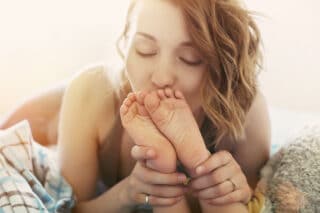
More Podiatry Foot Care Articles
Caring For Your Children’s Feet

You worry about your children’s teeth, eyes, and other parts of the body. But what do you do about your child’s feet – those still-developing feet which have to carry the entire weight of the body through a lifetime?
Many adult foot ailments have their origins in childhood and are present at birth. Periodic professional attention and regular foot care can minimize these problems in later life.
Neglecting foot health invites problems in other parts of the body, such as the legs and back. There can also be undesirable personality effects.
A child with troublesome feet walks awkwardly and usually has poor posture.
As a result, the child may become shy and introverted, avoid athletics and social functions. Consulting with a podiatrist, pediatrician and other medical specialists can help resolve these related problems.
Your Baby’s Feet
The human foot – one of the most complicated parts of the body – has 26 bones, and is laced with ligaments, muscles, blood vessels and nerves. Because the feet of young children are soft and pliable, abnormal pressure can easily cause deformities.
A child’s feet grow rapidly during the first year, reaching almost half their adult foot size. This is why foot specialists consider the first year to be the most important in the development of the feet.
Here are some suggestions to help you assure that this development proceeds normally:
- Look carefully at your baby’s feet. If you notice something that does not look normal to you, seek professional care immediately.
- Cover baby’s feet loosely. Tight covers restrict movement and can retard normal development.
- Provide opportunities to exercise the feet.
- Change the baby’s position several times a day.
Starting to Walk
When the child first begins to walk, shoes are not necessary indoors. Of course, when walking outside or on rough surfaces, babies’ feet should be protected in lightweight, flexible footwear made of natural materials.
Growing Up
As a child’s feet continue to develop, it may be necessary to change shoe and sock size every few months to allow room for the feet to grow. Although foot problems result mainly from injury, deformity, illness, or hereditary factors, improper footwear can aggravate preexisting conditions.
The feet of young children are often unstable because of muscle problems which make walking difficult or uncomfortable. A thorough examination by a podiatrist may detect an underlying defect or condition.

















